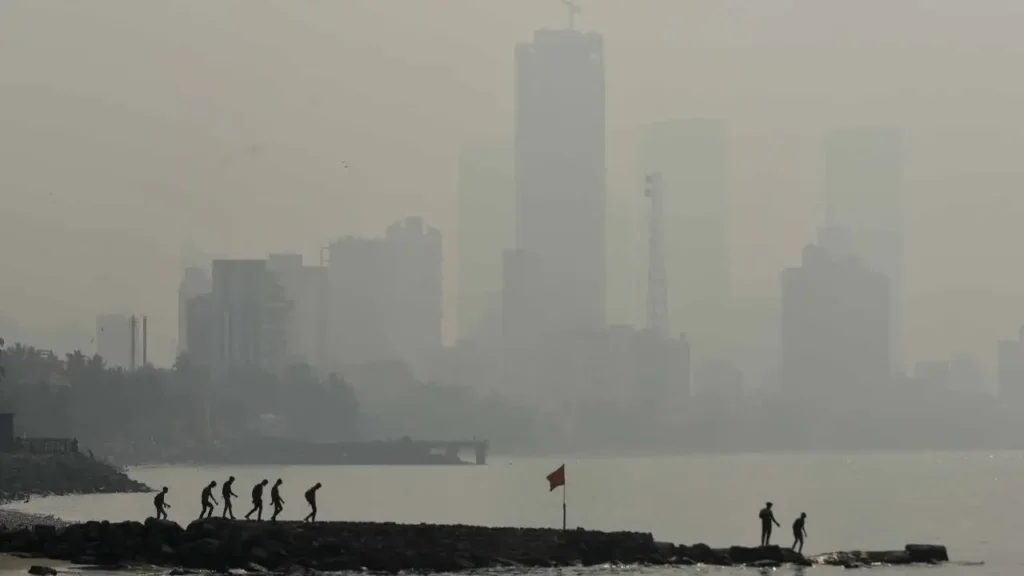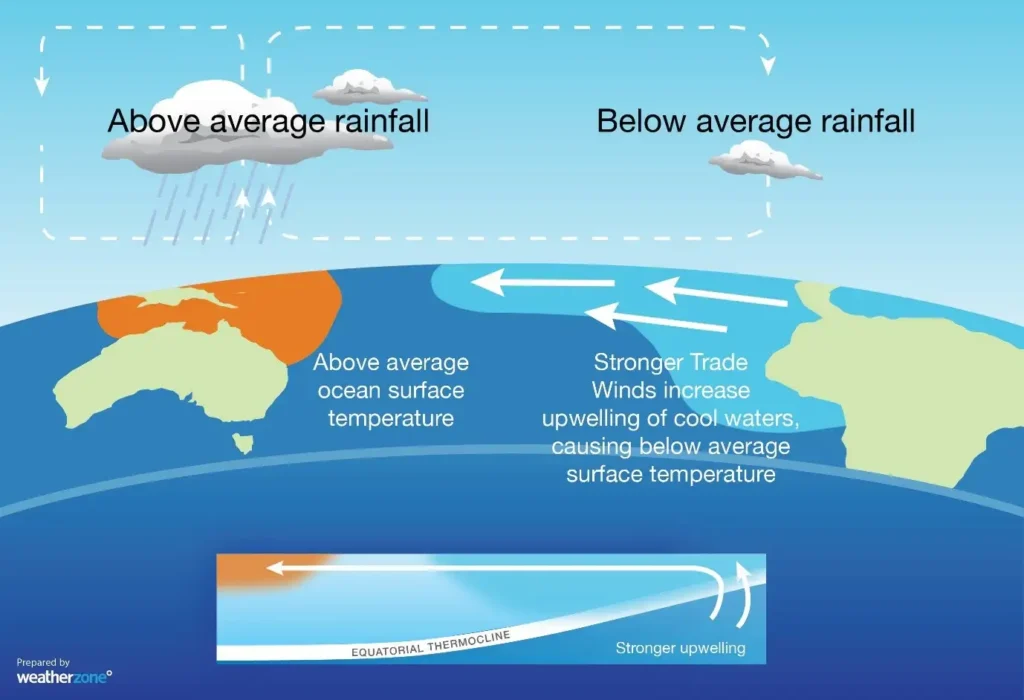A recent scientific study links climate change and the triple dip La-Nina phenomenon to deteriorating air quality in Mumbai during the winter of 2022.
Findings of the Study:
- The study, titled “Triple dip La-Nina, unorthodox circulation and unusual spin in air quality of India,” points to climate change and the La Nina phenomenon as key triggers for a significant decline in air quality, with Mumbai experiencing a 30% increase in PM2.5 levels.
- Worst Deterioration in AQI: Mumbai faced the worst decline in Air Quality Index (AQI) during the winter of 2022, marked by 66 days of poor air out of 92 days between November 2022 and January 2023.
- Role of Climate Change and La Nina: The study identifies climate change and the La Nina phenomenon as key contributors to the deteriorating air quality.
- Delayed wind reversals from the sea and less frequent calm winds, triggered by La Nina and climate change, were instrumental in trapping pollutants.
- Impact of Climate Change on Mumbai: Despite Mumbai’s geographical advantage of proximity to the sea, the study highlights that climate change disrupted normal wind conditions.
- The delayed wind reversals prevented the dispersion of pollutants from sources like biomass emissions and construction dust.
- Longer Duration of La Nina: Unprecedentedly, the La Nina phenomenon lasted for threeyears in the previous cycle, exacerbating the impact on Mumbai’s weather.
- Climate change further amplified the unusual weather conditions.
- Vulnerability to Climate Change: The study underscores Mumbai’s vulnerability to climate change and warns that if drastic steps are not taken to address emissions at the source, poor AQI levels during winters could become a regular occurrence.
Comparison with Northern States:
- Contrasting Trends: While Mumbai experienced a 30% increase in PM2.5 levels, the same factors led to improved air quality in northern states during the 2022-23 winter.
- Improvement in Northern States: Ghaziabad recorded the best improvement at 33%, followed by Rohtak at 30%.
- Despite stubble burning, Delhi’s AQI improved by 10%.
- Intrusion from Stubble-Induced Pollution: The change in La Nina affectedwind direction, causing significant intrusion from stubble-induced particulate pollution in Punjab-Haryana to western India, including Mumbai.
- This intrusion usually goes to Delhi and surrounding regions.
Causal Factors:
Wind Direction Change:
- The winter of 2022-2023 coincided with the last phase of an unusual triple-dip La Nina event.
- This event is the first in the 21st century and is influenced by climate change.
- The triple-dip La Nina event impacts large-scale wind patterns.
- In the winter of 2022-2023, a change in the normal wind direction was the most important factor in explaining the anomaly.
- Normally, wind in the north blows in a northwesterly direction, such as from Punjab to Delhi and further into the Gangetic plains.
- This is one of the main reasons why agricultural waste pollutants in Punjab and Haryana flow into Delhi.
- However, in 2022-2023, delayed wind reversals trapped pollutants, preventing them from dispersing.
- In the winter of 2022, the wind circulation was in the north-south direction.
- The pollutants being carried from Punjab and Haryana bypassed Delhi and surrounding areas and flew over Rajasthan and Gujarat to southern regions
- Local emission sources in Delhi and Mumbai remained unchanged.
- However, the additional pollutant load typically reaching Delhi from northern states followed a different trajectory, reaching peninsular India and even impacting Mumbai.
- This led to an improvement in air quality in north India, while peninsular India recorded an increase in pollution levels.
Local circulation of wind near Mumbai:
- The local circulation of wind near Mumbai also had an anomalous behaviour in 2022.
- Wind currents alternate between blowing from the land to the sea every few days.
- When blowing from the land towards the sea, the winds carry pollutants out of the city.
- In 2022, however, instead of changing direction every four to five days, the winds persisted in one direction for more than a week or 10 days, leading to greater accumulation of pollutants in Mumbai.
Relation with La Nina:
- Unusually Prolonged La Nina: The study emphasizes the persistence of a strong La Nina for an unusually long three years, contributing to distinct wind patterns affecting air quality.
- Global Air Circulation Data: Computer models using global air circulation data tied to La Nina conditions revealed wind patterns over India, consistent with observed changes during the winter of 2022.
- Sensitivity to La Nina: The study suggests that not all La Nina events may produce noticeable changes, but the prolonged and intense nature of the 2022 La Nina event played a crucial role.
- Accumulative Impact: An accumulative effect of La Nina on air quality becomes evident, particularly in the third year of its occurrence.
About La Nina:
- La Niña is a climate phenomenon that is part of the broader El Niño-Southern Oscillation (ENSO) cycle, which refers to the periodic fluctuations in sea surface temperatures and atmospheric conditions in the equatorial Pacific Ocean.
- La Niña is characterized by cooler-than-average sea surface temperatures in the central and eastern equatorial Pacific.
- It occurs every 3 to 5 years, but can sometimes occur over successive years.
Key features of La Niña:
- Cooler Sea Surface Temperatures: La Niña occurs when there is a strengthening of the normal patterns of easterly trade winds across the central and western Pacific.
- These winds push warm surface waters towards the western Pacific, allowing cooler waters to upwell in the central and eastern Pacific.
- Atmospheric Effects: The cooling of sea surface temperatures affects the atmosphere, leading to changes in weather patterns globally.
- La Niña typically results in increased rainfall in some regions and drought in others.
Impact on Weather Patterns:
- Increased Rainfall: La Niña tends to bring above-average rainfall to the western Pacific, Southeast Asia, and parts of Australia.
- This can lead to flooding in some areas.
- Drier Conditions: Conversely, some regions, such as the southwestern United States and parts of South America, may experience drier-than-average conditions, leading to drought.
- Hurricane Activity: La Niña is associated with an increase in Atlantic hurricane activity.
- Warmer waters in the Atlantic, coupled with reduced wind shear, create favorable conditions for hurricane development.
Ref: Source
| UPSC IAS Preparation Resources | |
| Current Affairs Analysis | Topperspedia |
| GS Shots | Simply Explained |
| Daily Flash Cards | Daily Quiz |




